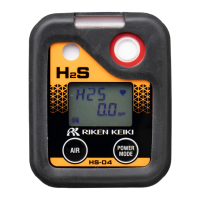2. Important Safety Information 2-2. Warning information
13 / 79
For calibration, use a standard gas consisting of the detection target gas diluted with nitrogen or air.
Calibration can be performed with a gas mixture that includes other components; however, such calibrations will
result in poor sensitivity and inaccurate concentration readings.
Sensor handling
Never disassemble the sensor inside the product.
Contact with the electrolyte inside the sensor may result in skin inflammation. Contact with eyes may result in
blindness. Contact with clothing may result in discoloration or holes. If contact with electrolyte occurs, rinse the
area immediately with plenty of water.
Do not use any gas other than nitrogen as the balance gas when calibrating or adjusting the oxygen sensor.
Miscellaneous
Do not dispose of the product into fire.
Do not wash the product, either in a washing machine or an ultrasonic cleaning machine.
Do not block the buzzer sound opening. Doing so will muffle or silence the audible warning.
Do not remove the batteries while the power is turned on.
WARNING
Battery replacement or sensor replacement
An OVER alarm may occur if the power is turned on within 10 minutes of replacing the batteries or the sensor.
This is due to the characteristics of the sensor.
If an OVER alarm occurs in fresh air after replacing the batteries or the sensor, turn off the power, then turn the
power on again after waiting at least 10 minutes.
C

